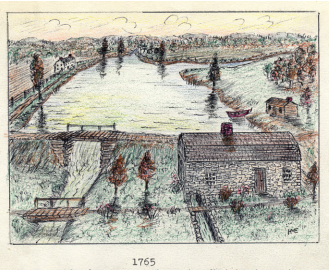Next to food and shelter, there was a great need for serviceable clothing on the part of the early settlers. To properly comb wool and turn it into yarn required considerable power and it was for this purpose that an earthen dam was built at Oak Street. The road at that time went over the top of the dam breast.
Since St. James Church on West Center Street was no longer in use, the log building was moved here and provided a home for the miller.
At that time the San Domingo creek was a large body of water and can be seen (in the drawing) entering the dam. Just beyond was the Congregational farm donated by George Klein. The barn can still be seen on Water Street.
To the left was the first Gemeinhaus which was built after Count Zinzendorf’s experiment in uniting all faiths at St. James Church had failed. It was here in 1748 that the first school in Lititz was founded with four boys and three girls.
Adjoining the Gemeinhaus was the “Single Sisters’ six acres of rye” and directly below the carding mill was the community distillery. Regardless of present day opinions on whiskey, it was a “cure-all” in the early days being used as a medicine and an antiseptic. It also served as both eye-opener and night-cap.
The carding mill was described by Henry Muth who added a second story for a residence, as unique in many ways. Instead of the conventional water wheel used at this time on the side of a building, the water here was taken directly into the house and operated a kind of turbine. The tail race leaving the building is still functioning after two centuries.
Carding was a difficult process. First the wools were scoured and blended and then they would be fed into the many drums with steel teeth that would eventually comb out the wool in preparation for spinning into yarn on mule frames. When the finished product was ready for the weaver, it would be sent to the shop back of the Brethren’s House. Here the men and boys would interweave it with the flax from the Sisters’ House and the result would be cloth called “linsey-woolsey.” Probably not too soft on the skin but very serviceable. At first the only dye available was from the walnut, but by the time Johannes Mueller set up his shop he could supply almost every hue of the rainbow.
The carding mill dam was one of the seven that would some day dot the length of the Lititz creek. It was Dr. Herbert Beck’s claim that there were more dams in this five mile stretch of creek than anywhere in the country.
